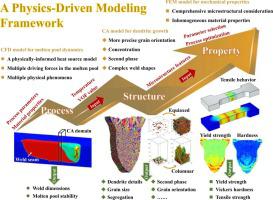Journal of Materials Processing Technology ( IF 6.7 ) Pub Date : 2022-06-30 , DOI: 10.1016/j.jmatprotec.2022.117703 Ziyou Yang , Hui Fang , Kangning Jin , Jingshan He , Wenjun Ge , Wentao Yan

|
The process-structure-property relationship has always been the research focus in welding, where computational prediction is valuable. However, some important physical phenomena are often simplified when modeling the melting and solidification processes. In this work, an integrated modeling framework is adopted to comprehensively predict the welding quality, from a computational fluid dynamics (CFD) model for molten pool dynamics, to a cellular automata (CA) model for dendrite growth, and finally to analytical and finite element method (FEM) models for mechanical properties. Using Al-Cu alloy as a model material, the complex melting and solidification processes in electron beam welding is reproduced, and various strengthening mechanisms are considered to predict the mechanical response. Notably, the material property inhomogeneities due to inhomogeneous microstructure in the welds are considered when predicting the overall mechanical properties. Based on the simulation results, the second phase strengthening proportion reaches almost 50%. The maximum relative errors of predicted Vickers hardness and tensile strength are 13.62% and 13.30%, respectively. The simulation results show quantitative agreement with experimental data, demonstrating the appealing potential of this modeling framework. This study could be helpful for optimizing the actual welding process to tailor the microstructures and mechanical properties.
中文翻译:

从熔池流动、微观结构到机械性能的 Al-Cu 合金电子束焊接物理驱动建模
工艺-结构-性能关系一直是焊接领域的研究热点,其中计算预测很有价值。然而,在对熔化和凝固过程进行建模时,通常会简化一些重要的物理现象。在这项工作中,采用集成建模框架来全面预测焊接质量,从熔池动力学的计算流体动力学 (CFD) 模型到枝晶生长的元胞自动机 (CA) 模型,最后到解析和有限元机械性能的方法 (FEM) 模型。以Al-Cu合金为模型材料,再现了电子束焊接中复杂的熔化和凝固过程,并考虑了各种强化机制来预测机械响应。尤其,在预测整体机械性能时,要考虑由于焊缝中不均匀的微观结构导致的材料性能不均匀性。根据模拟结果,第二相强化比例接近50%。预测维氏硬度和抗拉强度的最大相对误差分别为13.62%和13.30%。模拟结果显示与实验数据的定量一致性,证明了该建模框架的吸引力。这项研究可能有助于优化实际焊接工艺以定制微观结构和机械性能。预测维氏硬度和抗拉强度的最大相对误差分别为13.62%和13.30%。模拟结果显示与实验数据的定量一致性,证明了该建模框架的吸引力。这项研究可能有助于优化实际焊接工艺以定制微观结构和机械性能。预测维氏硬度和抗拉强度的最大相对误差分别为13.62%和13.30%。模拟结果显示与实验数据的定量一致性,证明了该建模框架的吸引力。这项研究可能有助于优化实际焊接工艺以定制微观结构和机械性能。











































 京公网安备 11010802027423号
京公网安备 11010802027423号